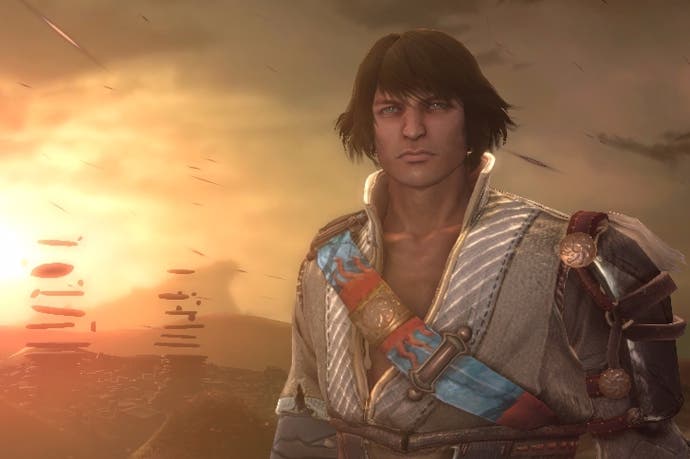Stormlands and the million-man raid: Obsidian's cancelled Xbox One exclusive
"That deal was the largest contract we ever signed."
Earlier this week, I got the chance to talk to Obsidian about its brand new role-playing game Avowed. This is the game it's making for relatively new owner Microsoft, so in some respects, it's a product of a new Obsidian era. But it's not the first big RPG Obsidian has made for Microsoft and Xbox. As I discovered when I went to visit the studio a couple of years ago - oh god it's actually six - there once was another. It was a game with an incredibly ambitious idea at its heart - a million-person raid - and it was also a game that would never, perhaps understandably, come out. Nevertheless, Obsidian boss Feargus Urqhart was happy to tell me all about it, so this is the story of it - of Stormlands.
While I'm digging around in our Obsidian drawers, though, I should say it's not the only story I heard during that visit. I also heard about the Making of Alpha Protocol, which is an underrated spy RPG, and I dug around in Obsidian's drawers too, appropriately, pulling out all kinds of partially used game ideas the studio has hoarded over the years. I wonder if any will ever resurface.
Throw your mind back to Microsoft sharing a dream of an infinitely powerful Xbox One cloud, a box under your TV able to suck an almost mystical power into your living room, transforming games as we know them. The vision wouldn't quite materialise, but while Microsoft was hallucinating over the cauldron it was also throwing money around - throwing money at Xbox One exclusives to embody this future, and Obsidian Entertainment was spinning in its pot.
"We were given a proposal, the million-man raid," Obsidian co-owner and CEO, Feargus Urquhart, tells me. "Conceptually what came from Microsoft was this idea: imagine you're playing The Witcher, maybe with a friend. What happens if at points in time a giant creature pops up that you can see in the distance and it's not just popping up while you're playing, it's popping up for everybody who's playing. You all rush this creature and there's this haze around it, and as you're all rushing through the haze the game is matchmaking you into 40-man raids who are going to fight the creature.
"Then you fight it, but while the creature is being fought all the footage is being recorded up into the cloud. Then at the end we would come up with some kind of intelligent editing thing which would deliver everybody who fought a personalised, edited video of their participation in the raid. That is what was proposed to us."
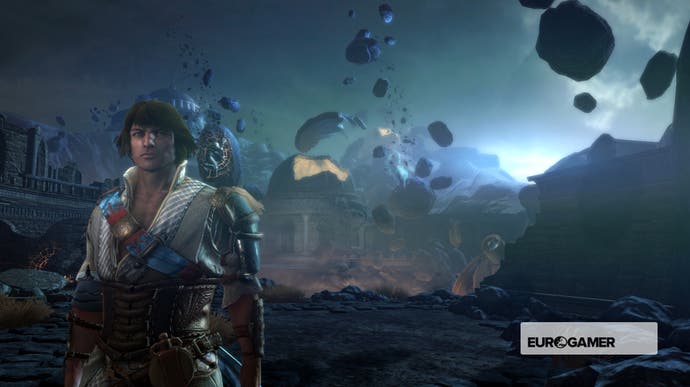
"Microsoft's ambition," says fellow owner Chris Parker, vice president of development, "was to do a lot of things and do it very new. Nothing that was standard or typically accepted in video games should be taken as acceptable. It was always, 'Try to get it up to the next level, try and figure out something different or some new way to approach it or put a different spin on it.' Every feature it was, 'How do we change this feature to make it better than it has ever been before?'"
This game was a big deal, an exclusive Xbox One launch game, and barring four and a half years of Armored Warfare cheques it would be the biggest deal Obsidian would ever sign - bigger than Fallout: New Vegas, South Park: The Stick of Truth, the lot. Microsoft was even already talking about a sequel. "They wanted to invest in a developer and IP over the long-term," Urquhart says. "That deal was the largest contract we signed."
The game was Stormlands, codenamed North Carolina, and it would never see the light of day.
Stormlands! Obsidian had been sitting on the idea in some form since 2006, and in early 2011 finally had the chance to work it into a pitch for Microsoft, titled Defiance. "OK well this is interesting," Microsoft said, "but it feels a little bit too trope-ish, a little too standard, so are there ways you can try and reinvent things and try and make it a little bit different?"
Sensing a big opportunity - a platform holder with a new console - Obsidian threw the kitchen sink at the rewrite. "We're going to pitch a big game and we're going to do it like all real developers pitch stuff instead of our normal three-page [proposal]," says Urquhart, "so we're going to do a demo and we're going to put a real pitch together and a Power-Point - a whole package."

Some of the fundamental ideas from Defiance remained but the world was taken in a more dramatic direction, aiming for something far less standard than in other role-playing games. What Obsidian returned to Microsoft with was Stormlands, a game set in a world of crazy storms, where the storms themselves factored into magic you used.
But Obsidian wasn't under any illusions of success. "We had no expectations," says Urquhart. "There's no way they're going to sign us," they thought. But something about the pitch-booklet emailed had evidently struck a chord, because when Obsidian went up to Redmond to present the Stormlands demo, all the big shots at Microsoft were there.
"We had a demo on the Xbox 360 and they asked us a lot of questions," says Urquhart, "and then I was really surprised because we went downstairs and we were waiting for a taxi and Noah [Musler, Microsoft Game Studios biz dev] came down and said, 'I don't want to get your hopes up but I think we're looking good.' And he'd never shown any - that was the most positive he'd been about any of our proposals.
"We started talking pretty soon after that."
Stormlands was to be a third-person action role-playing game with a camera behind the character as in Fallout: New Vegas. "The fighting was super-action," not like Dark Souls, more like The Witcher, Urquhart says - the difference being Stormlands would have companions.
While we're talking about the game, he rummages through boxes in his office looking for the Stormlands booklet, but sadly he never finds it. What he does find, though, is the original Xbox 360 pitch demo and he loads it on his PC. The screenshots you see in this article are from that demo and have never been seen outside of Obsidian or Microsoft before. Don't you say I never do anything for you, you rotters!
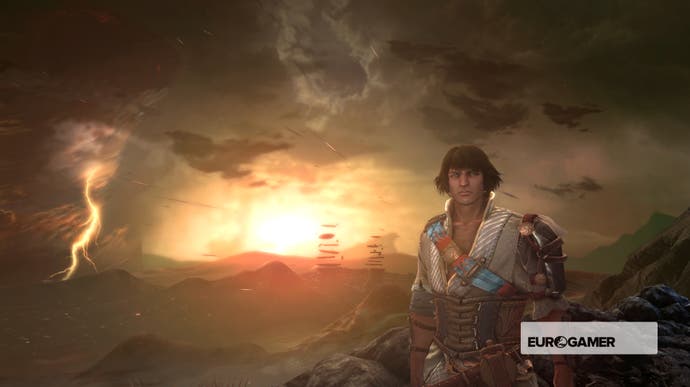
The demo, running on the Dungeon Siege 3 engine, is visually impressive, even now, several years and a new console later. There's a bruised peach tone to the otherworldly sky, which rumbles and crackles with storms while a haunting kind of Arabian music moans in the background. It reminds me immediately of Assassin's Creed or a Prince of Persia, with the main character, a man, wrapped in similar-styled clothes, a cloak slung over one shoulder. There's a brooding atmosphere, helped no end by the bodies a storm has entombed in the rocky mountainside around us.
We eventually come across a female character who was to be one of your companions. She takes her facial armour off before talking to us, which is a nice touch - it bugs me in other RPGs when characters waffle away like noisy, bobbing helmets. A classic dialogue screen of choices appears and the characters interact, fully voiced. On the horizon is a kind of castle we're aiming for and from which, by the demo's culmination, a huge enemy erupts. "That was the pitch that got us the project," says Urquhart as it ends.
He loads a Stormlands development milestone video on his screen afterwards, which revolves around combat and is narrated by one of the Stormlands team. This appears in grey-box form so there are no textures only a smooth grey skin coating everything - characters, enemies and terrain. In this video I see the character rolling to evade attacks, as in The Witcher, and teleporting short distances, as Ciri does in The Witcher 3. I also see a variety of acrobatic attacks used against a variety of enemies, from beast men to wraiths. Crucially I see companion moves too, special attacks you can trigger allies to perform - it would always be you and one other on a level. These companions and these special partner moves were to be a fundamental cornerstone of the Stormlands experience.
Clearly a lot of work had been done. What, then, went wrong? There was a disconnect, a juxtaposition between a dreaming Microsoft on one hand and an Obsidian who had to realise the ideas on the other. One moment Obsidian was talking to a Microsoft executive producer about doing co-op, the next minute a new executive producer was pitching million-man raids. "We look at something like that and it's like, 'Holy Jesus!'" says Urquhart.
But it's important to point out Obsidian never took the million-man raid idea literally, and never believed Microsoft, as ambitious as it was, meant it that way. "This happens with everything," he says. "We do this when we're talking to our people, we give them crazy ideas. The goal was to inspire us to come up with not that, but inspire us to think about how to incorporate all of these elements." It's like the story of the Sony boss running downstairs to the inventors' lair with a pack of playing cards and declaring, "I want a tape player I can stick headphones into that's this big!" and in doing so triggering the creation of the iconic Walkman.
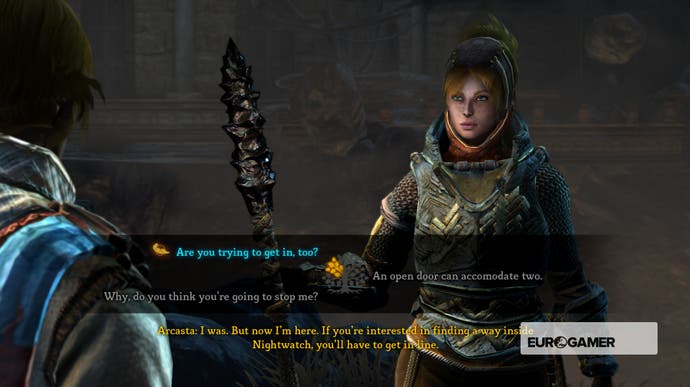
Nevertheless the demands from Microsoft to reinvent the wheel were high. Kotaku writer Jason Schreier talks about Kinect-powered verbal haggling in Stormlands, in his new book Blood, Sweat and Pixels, which I heartily recommend. Chris Parker and Feargus Urquhart don't recall that exact feature when I talk to them but concede there were so many ideas it may well have been one. Ideas piled upon ideas and all the time the immovable deadline to be ready for Xbox One launch loomed closer.
Microsoft's answer? Throw more resources at it. "At some point Microsoft was saying 'maybe this needs to be an even bigger game'," Urquhart says. "'Maybe we just need to add a bunch more people onto it - maybe we don't have enough people to prototype all these crazy ideas we have.' Well no, actually that sounds terrifying, that sounds like a really bad idea for us to do."
"Sometimes adding people to something doesn't mean it's going to get done any faster," adds Chris Parker. "It's actually just going to be more complicated, more people running down the wrong path."
"I just wish I had flown out to Seattle and got a meeting with Don Mattrick and everybody else," says Urquhart, "and said, 'OK we all agree it would be good to have an RPG at or very close to the launch of Xbox One. We can make RPGs, it's been shown. These are the challenges we have on the table:
"Unreal 4 doesn't exist for the Xbox One yet. We can use Unreal 3 but Unreal's transitioning so that's not good, so we're using our own engine and it's doing great in certain ways but we still have to build it up in other ways. The second challenge is we've not done a lot of multiplayer stuff before. The next challenge is this is a launch title so that date, it's not a 'well if it ships here you're late but that's fine'. We're all doing this, and you guys are on board doing this, because you want it to be a launch title. How do we now make a game that is realistic within all those challenges?

"And I didn't do that," he says, "and that probably contributed to the game getting cancelled."
In March 2012, Feargus Urquhart got a phone call and it was Microsoft cancelling the game. "You get a call, it's always a call," he says. He'd half expected as much but it was a hammer blow nonetheless, and effective immediately, no room to manoeuvre, no way out. He called the other four company owners together for a meeting in a coffee shop the other side of town - there was no way they were risking someone walking into this one.
"The thing you have to have in a situation like that is a plan of some sort," he says. "People need to know there's leadership and moving forward. We can't just get everybody together and say 'we're going to do a layoff' because people will go home [and worry] 'am I going to get laid-off tomorrow?'"
The next day, plan in hand, Obsidian gathered everyone together who would be laid off into one room and told them the bad news. As HR took over, the rest of the company gathered out of earshot in the big canteen and was told the news. "I think we said, 'If you want to leave for the rest of the day, you can, because it's a shitty day and you're probably not going to get any work done anyway,' says Chris Parker. "Then we dealt with the people we were laying off to try and get them all sorted."
The day after was all about building hope for the future by assigning key people to work up new pitches to find new work, fast. Obsidian had South Park in development but THQ was crumbling away. "Nobody really has any time to mourn, nobody really has any time to worry about it," Parker says. "Everybody is on point with, 'What are we doing now? [The layoff] was yesterday, yesterday sucked. We're done with it. In three weeks once we've got all these proposals out we're going to get together and have a beer and shed a tear, but right now we need to move forward.'"
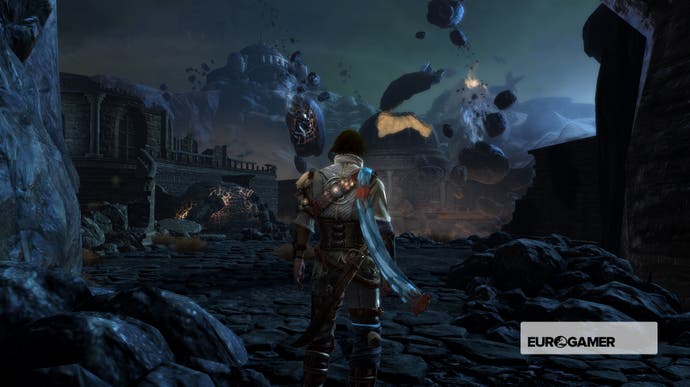
The Stormlands cancellation began what Obsidian refers to as the Summer of Proposals, where around 10 ideas were pitched to almost every publisher under the sun, and I'll tell you about a bunch of those early next week. Stormlands, meanwhile, wasn't wasted, but was worked into a new pitch for a new game called Fallen, with an even darker world. "We pitched Ubisoft, we pitched 2K, we pitched everybody." says Urquhart. "A lot of people we'd pitched Stormlands to and it was a challenge to re-pitch a game that had now been cancelled. It makes sense - why pick up a game that another publisher cancelled?"
No one ever did pick up Fallen but thrifty old Obsidian salvaged the idea yet again, creating another pitch which Paradox would sign at the beginning of 2014. It became Tyranny, which received the expansion Bastard's Wound this week.
As for Obsidian and Microsoft, whatever bridges were burned now sound repaired, and Urquhart maintains contact. He even says - in response to a question about how hard it is for independent developers to find work today, in an age where publishers do so much more internally - "Microsoft is looking..." which bodes very well.
Currently, however, Obsidian's hands are full, the 175-person studio occupied across four and a half projects: the Tyranny expansion, Pillars of Eternity 2, a small Pathfinder card game, a small idea the studio is "spinning up" and a considerable something else. And I'll tell you a bit more about that next week as well.
Disclaimer: Travel and accommodation for this trip was provided by Paradox Interactive.
